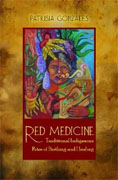Red Medicine
Patrisia Gonzales
book reviews:
· general fiction
· chick lit/romance
· sci-fi/fantasy
· graphic novels
· nonfiction
· audio books
· author interviews
· children's books @
curledupkids.com
· DVD reviews @
curledupdvd.com
newsletter
win books
buy online
links
home
for authors
& publishers
for reviewers

 |
Red Medicine: Traditional Indigenous Rites of Birthing and Healing (First Peoples: New Directions in Indigenous Studies) Patrisia Gonzales University of Arizona Press Paperback 272 pages May 2012 |
|
The author of this intriguing sociological, psychological and folkloric study of the rituals of birthing is a member of the faculty at the University of Arizona, a Native American, and a Kellogg Fellow who has received human rights awards for her national columns and her earlier book, The Mud People.
One of her contacts, Lucila, speaks in this way about the birth experience: “Being pregnant and growing a child inside of my womb definitely felt like a ceremony every single day. Your entire body is a sweat lodge for the baby.” Then, “Now your baby is outside, When you take your baby to present the baby to the Sun, the wind, the Earth, the stars, you want to be prepared physically and mentally.” Gonzales leads us into a mystical world of origin lore, in which the “Spider Woman” represents centeredness, and the “witch’s broom” is a “limpia” that expresses the mythic power of women in the home. In this world, the umbilical cord is a thread that leads us back to the past and links us to all births, all babies. In Mexico, women’s shawls and braids are part of the birthing ceremony; sweeping, bathing, and lighting candles are shared symbolic actions that draw Mesoamerican women together in the ritual of birth. The author envisions herself “sweeping up indigeneity [sic]” and sweeping away “those ideas of what is no longer useful.” She states “In my re-search across time and spaces, I present another understanding of the phenomena found in ceremonial formulas of Spider that rethreads a web of meaning for today’s Red Medicine.” Such emotive verbiage, redolent of the Latin American novelists and poets, gives this incidentally erudite book a home in the house of spirits. Originally published on Curled Up With A Good Book at www.curledup.com. © Barbara Bamberger Scott, 2012 |
|
|
|
 Click here to learn more about this month's sponsor! |
|
| fiction · sf/f · comic books · nonfiction · audio newsletter · free book contest · buy books online review index · links · · authors & publishers reviewers |
|
| site by ELBO Computing Resources, Inc. | |
 Though this is an academic work, it uses the language of magic and a rather old-fashioned approach to human history and development, drawing not only from what the author calls IK (Indigenous Knowledge) and modern midwifery but
also from such disparate sources as the Brazilian educator Paulo Friere: “I do research so as to know what I do not yet know and to communicate and proclaim what I discover.” Most latter-day academics are too arrogant to make such an assertion. The author takes a humble approach to her subject matter, having been trained by indigenous elder midwives and having observed many births in traditional homes where an infant may be brought into the world in front of a family altar, the umbilical cord cut over an ear of corn that will later be planted by the child as a reminder of his or her eternal connection to the rites of birth, ceremonial time, and inner growth.
Though this is an academic work, it uses the language of magic and a rather old-fashioned approach to human history and development, drawing not only from what the author calls IK (Indigenous Knowledge) and modern midwifery but
also from such disparate sources as the Brazilian educator Paulo Friere: “I do research so as to know what I do not yet know and to communicate and proclaim what I discover.” Most latter-day academics are too arrogant to make such an assertion. The author takes a humble approach to her subject matter, having been trained by indigenous elder midwives and having observed many births in traditional homes where an infant may be brought into the world in front of a family altar, the umbilical cord cut over an ear of corn that will later be planted by the child as a reminder of his or her eternal connection to the rites of birth, ceremonial time, and inner growth.